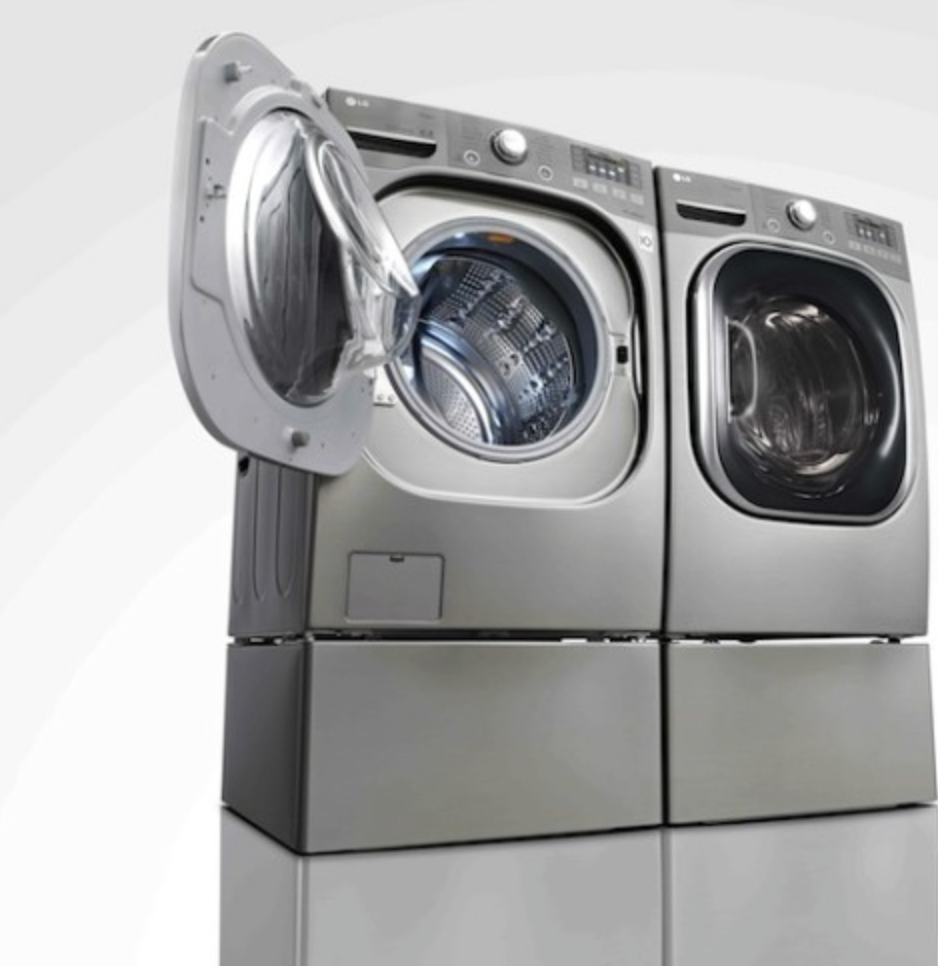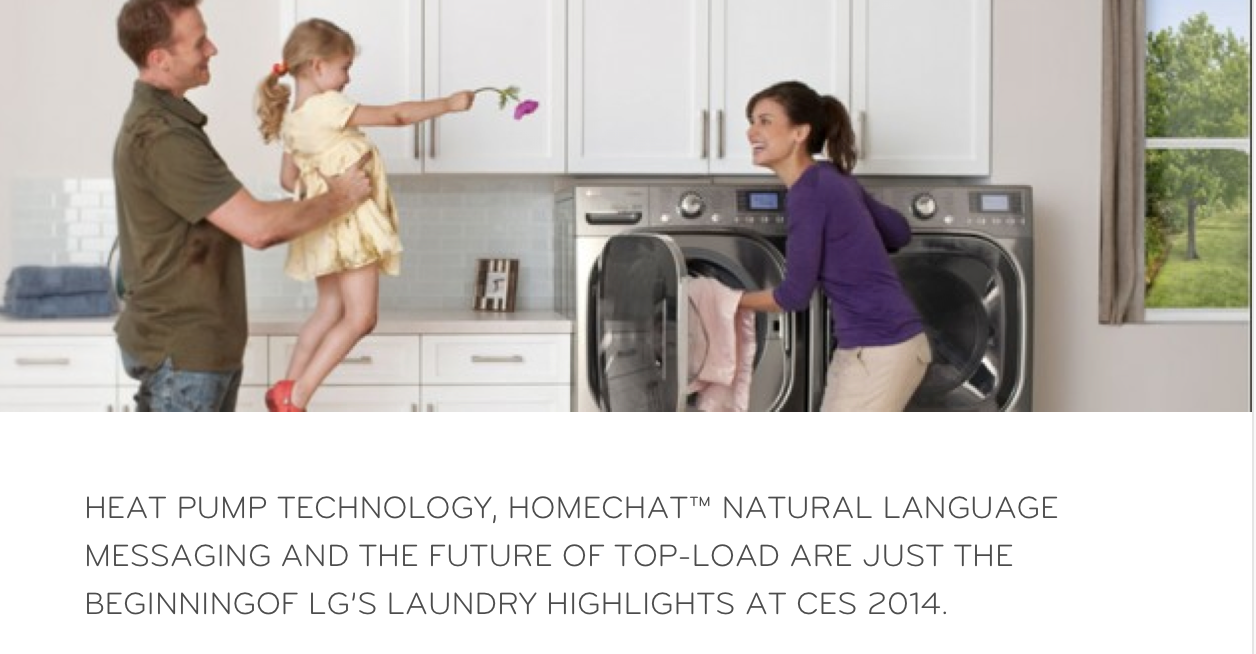
Heat Pump Dryers Finally Coming to the US
(Promo image LG)
Building a net zero energy house, or a passive house depends heavily on how well you are able to control air leakage from the home. A significant amount of time, planning, and expense goes toward getting air leakage down to a bare minimum. So after you've finally gotten it down to record setting ACH values, the idea of drilling a 4" diameter hole thru the wall and pumping out heated air at high speed is the last thing you want to do. But unfortunately, that's exactly what the typical dryer installation requires.

(Image: Promo image LG)
Wether you buy the cheapest dryer on the market, or the latest one with WI-FI and voice recognition that greets you by name, they all have one thing in common. They need a way to get that hot humid air out of the dryer and replaced with fresh dry air to help dry out your clothes. The dry air comes from, you guessed it, your indoor home air. Air that your air conditioning system is working hard to cool during the summer, and your furnace is working hard to warm up during the winter. The dryer does not discriminate or care how wonderfully your state of the art HVAC system has achieved the perfect temperature balance in your home, it want air like a starting lion. It sucks it in constantly during the drying process, heats it using an electric or gas heating system and then blows it across your tumbling pile of wet clothes hoping to get whatever moisture it can, and then goes straight out the back of the dryer, thru a poorly designed hose ( that the manufacturer does not care to design or supply with the equipment), and straight out thru a hole in your wall to freedom. As your home loses that air, cold winter air of hot summer air is seeping in thru the cracks around your home to replace it. Your heating or cooling system then kicks in to get it back to a comfortable temperature. What does this process cost you? After you stove, it is most power hungry device in most home, and we are not even counting the energy that your HVAC system needs to put into the new replacement air coming into your home.
There have been attempts by creative individuals to extract the heat energy from the waste air before dumping it outside. Some people have even tried pumping the air back into their home after filtering out the lint. These DIY type solutions solve one problem, but create many others in the process. The air coming out that hose is not only hot, but also high in humidity, lint, and loaded with whatever chemicals in your detergent. Not the best air to be breathing down your lungs. If your home is built tight, then the problem is even worse as that extra humidity will lead to mold and other issues throughout your home. Not surprisingly, the europeans have had a solution to this readily avialble to consumers for over a decade. The heat pump dryer.
A heat pump dryer solves this problem and provides several benefits that are especially important if you are building a super insulated home. First, say goodbye to the dryer hose out the back, and out the wall! That's right, no vent, no air being blown out of your house. not only that, but its not sucking huge volumes of air from your living space either. That is a huge benefit for a net-zero energy home, or passive home. Your conditioned air stays in the home, and none of it being pumped out the walls. Not to mention, easier installation, without having to punch a hole in your wall. Do not confuse this technology with ventless dryers that have been around the US for years. Those are still the old school dryers we talked about above trying to avoid venting out.
Heat pump dryers work on a completely different principle. They use a heat exchanger similar to what you find in a air conditioner. A little bit of heat transfer learning is needed here. Heat is energy that travels from areas of high heat to areas of low heat. There is really no such thing as cold, only heat and less heat. You can move heat from one area to another and in the process the area that you take heat away from becomes colder, and the area you add heat to becomes warmer. You can create heat by converting another form of energy into heat, for example by converting electric energy into heat energy. You cannot create cold however. Cold is simply what you feel when heat is taken away. A heat pump is a device that moves heat from one point to another. An air conditioner does NOT put cold into a room. What it does is take heat out of the room and move it outside. In the process the room which lost heat,feels colder. Stay with me here, there is a reason this is important. The heat pump in the AC has two sides. One side is loosing heat ( feels cold), the other side is gaining that heat ( feels hot). Its the same heat, the heat pump simply moves it from one side to the other.
One more bit of science before we put it all together. Ever notice how humid muggy days only happen in summer? and dry crisp days only happen in the winter? That is because the ability of air to hold water changes with temperature. Hot air can hold more water vapor, which is great because heat also makes water vaporize ( become steam, a gas, instead of liquid). As the sun heats up water in the summer, it evaporates from soil, and lakes, and becomes water vapor in the air. The hot humid air feely muggy and sticky with some days hitting 100% humidity levels. In winter, the opposite happens. When humid air cools, it is no longer able to hold the same amount of water, and the water begins to condense back into liquid form. Take a look at your ice cold soda can next time you are sipping it on a hot humid day. Notice how the outside of the can get covered with drops of water, which quickly begin running down the side an leave a big ring on your table. That's not because you have a leaky can, it's because the hot humid air around the can is loosing it's heat ( which is moving into your soda and warming it as every minute passes....yep..you are starting to get it now.. the heat is moving form the air to the cold can). As the air gives up its heat, it can no longer hold as much water as it could before, and the water that you could not see as vapor in the air, begins to condense ( become a liquid again). The water was there all along, it the air, you just could not see it until it became a liquid.

(Promo image LG)
Ok, enough science. Let's put it all together. The heat pump dryer has a heat pump in it. The heat pump takes heat in the air on one side of it, and moves it to the other. One side biomes hot, the other becomes cold. The hot side is used to heat the air inside the drum with your clothes. The heat makes the water in your clothes begin to evaporate and the hot air is able to easily hold a lot of that moisture. The hot humid air blows out of the drum area, BUT instead of being blown out the wall, it is blown to the cold side of the heat pump. The cold side is like your ice cold can of soda on a supper muggy day. The heat from the hot air transfers into the cold side of the heat pump. Just like it warms your soda, it warms the cold side of the heat pump. Unlike you can of soda, the heat pump keeps pumping that heat away to the hot side again and thus the cold side keeps getting cold, and the hot air coming from the drum can keep blowing across it and transferring all its heat into it easily. As the air looses its heat, what do you thing happens to the water vapor that was in it? Just like the soda can, it condenses, into beads of liquid water and begins dripping. A tray continuously catches all the dripping and drains it out a water drain. The air is now cool and dry just like winter air, it's lost its heat, and its water. It gets looped around to the hot side of the heat pump again, and starts all over again. The same air gets blown around and around while the dryer runs. It never needs to leave the system. As it continues to go around, the water from the clothes keeps ending up as dripping condensation on the cool side of the heat pump! A brilliant approach to use not only heat from the hot side of a heat pump, but also feeding it right back to the cold side so its not sucking heat energy from your room and leaving it feeling cold like an air conditioner. And double brilliant to take advantage of water's properties of becoming vapor when heated and liquid again when cooled.
The process is brilliant, but not free of course, as electricity is needed to pump the heat from one side to the other, blow it around, run the drum, etc. etc. All said and done, it does cut the power consumption of the dryer in half vs. a conventional approach. In a normally home, you would save 50% of the energy which is off course great for the environment. In a super-insualted home you save even more because a heat pump dryer is not blowing hundred of cubic feet of heated or cooled air out of your home! That means your furnace doesn't have to compensate and your energy savings continue while maintaining a more constant indoor air temperature in your home.
We are glad to see this technology FINALLY making its way to US homes. It's still not mainstream, and certainly at a premium cost, but an important step in the right direction. As more people adopt the technology, the costs will finally begin to come down. For now, it's nice to not have to pay extra to ship something from Germany. Now if only the Swiss made washer with built in heat pump dryer was available.... hummmmm.

Comments